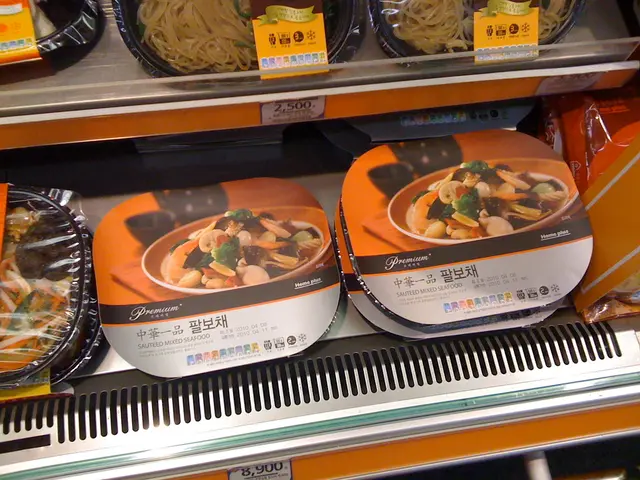AI Customizes Pet Food: A Look at the Advancements and Ethical Implications
At the break of dawn, stepping into the kitchen may reveal an unexpected sight: a meticulously prepared bowl of food tailored to your cat's unique dietary requirements, meticulously calculated to the gram. This scene represents the cutting edge of pet care, fueled by artificial intelligence (AI). The allure is undeniable: healthier pets, fewer vet visits, and the end of generic kibble. Yet, as AI infiltrates our pets' meals, questioning its benefits versus potential drawbacks becomes essential.
The Emergence of Data-driven Pet Care
Pet nutrition has traditionally been an art—a blend of educated guesses and instincts. However, thanks to AI, this is rapidly changing. By sifting through vast amounts of data, algorithms can transform the science of feeding into a more precise art form. These tools serve as a hybrid nutritionist, veterinarian, and chef working behind the scenes to ensure tail-wagging satisfaction and twitching whiskers.
How AI Understands Your Pet's Needs
At the heart of AI-enabled pet nutrition lies a web of interconnected data points. These systems meticulously analyze factors ranging from age and weight to breed and chronic conditions. Some platforms even utilize wearable tech to monitor a dog’s daily activity or a cat's sleep patterns. By comparing these details with extensive veterinary insights, AI offers meal plans that exceed the generic offerings you might find on store shelves.
Challenging Breed Stereotypes
It’s easy to assume that all Labradors or Siamese cats share the same dietary needs. AI, however, reveals an intricate web of individual differences often overlooked. For instance, two golden retrievers of the same age might require vastly different diets if one leads a sedentary lifestyle while the other trains for agility events. AI's ability to identify and address subtle differences challenges the concept of a "one-size-fits-all" approach.
The Evolution of Machine Learning in Pet Food Formulas
Machine learning algorithms, akin to eager students, continuously learn more with each new pet profile. As more owners contribute data, the AI grows smarter, spotting patterns between food ingredients and health benefits. This allows for more tailored pet food recipes to evolve at an unprecedented pace.
Gadgets for the Digital Feast
Pets are no longer excluded from the realm of digital gadgets. Wearables, like smart collars and GPS trackers, feed real-time data into AI systems, while smart bowls monitor food consumption habits. This constant flow of information allows AI to adjust nutritional advice in real-time, providing the equivalent of a personal chef who never sleeps.
Genetic Goldmines
It’s no longer simply about external observations. DNA kits for pets are as common as chew toys, offering insights into breed makeup, potential allergies, and disease risks. AI interprets this genetic information, recommending diets designed to avoid dietary triggers or support fragile health conditions, potentially transforming mystery symptoms into clear diagnoses.
Success Stories and Skepticism
Some pet owners extol the benefits of AI-driven nutrition, claiming improvements in coat quality, energy levels, and fewer vet visits. Lucy, a twelve-year-old beagle, is an example; her arthritis reportedly improved after AI recommended an omega-rich diet. However, skeptics voice concerns about relying too heavily on technology, questioning the possibility of errors and potential oversights that a human vet might catch.
Expanding the Scope of Personal Nutrition
Personalized nutrition isn't limited to traditional meals. AI can suggest supplements, such as glucosamine for joint support, or tailor treat intake to individual needs. For pets with allergies or chronic health issues, this attention to detail can make all the difference between discomfort and contentment.
Fighting Obesity with Innovation
Pet obesity is a growing epidemic, affecting more than half of dogs and cats in some countries. AI can offer a formidable weapon in the fight, setting precise calorie targets and monitoring progress with unwavering accuracy. This digital personal trainer can help pets maintain an ideal weight, enhancing their overall health and lifespan.
Navigating Chronic Conditions More Effectively
Pets with diabetes, kidney disease, or severe food sensitivities face constant nutritional challenges. AI steps in as a vigilant assistant, flagging risky ingredients and helping owners manage complex diets. This aids in reducing the risk of flare-ups or emergencies, providing peace of mind to concerned owners.
Co-existing: AI and the Human Touch
Regardless of its capabilities, AI isn’t meant to replace the bond between pet and owner or the wisdom of a trusted veterinarian. Instead, it acts as a partner, offering insights that humans might miss. The best results seem to occur when AI recommendations are used in conjunction with human instinct and veterinary guidance. After all, no algorithm can replace the joy in a dog’s eyes when it hears the word "dinner time."
Privacy Concerns: Owning Your Pet's Data
Given the sensitive nature of the data shared, privacy becomes a significant concern. Owners disclose intimate details about their pets’ health, habits, and genetic makeup. Establishing who owns this information is essential, as some companies promise strict confidentiality, while others may utilize the data for research or marketing.
The Price of Personalization
Personalized pet nutrition isn’t budget-friendly. AI-powered meal plans and supplements often are pricier than conventional kibble. While some owners find the benefits well worth the expense, others view it as a luxury they cannot afford, raising questions about equity in pet care and deepening existing inequalities.
Reducing the Environmental Footprint
The environmental impact of pet food production is substantial, encompassing factors like meat sourcing and packaging waste. AI can help minimize this impact by streamlining ingredient sourcing, reducing waste, and even recommending sustainable alternatives like insect-based proteins or lab-grown meat. If enough pet owners adopt these eco-friendly options, the environmental benefits could be significant, positioning pets’ bowls as environmental battlegrounds in the fight against climate change.
Striking a Balance: Over-Optimization and the Big Picture
The pursuit of precision can lead to losing sight of the broader picture. Pets, like humans, are resilient; occasional variety or table scraps can be beneficial. Some experts caution against obsessing over minor adjustments, reminding us that a balanced diet doesn’t necessarily need to be perfect to be effective. The challenge lies in finding that delicate balance between high-tech precision and the simple joys of pet ownership.
Vets' Perspectives: Help or Hype?
Many veterinarians view AI-driven nutrition optimistically, particularly for pets with complex needs. They appreciate the ability to monitor progress and adjust diets remotely. However, some worry that owners might neglect regular check-ups, favoring the algorithm over professional advice. The collective opinion seems to be: use AI as a tool, but rely on veterinary expertise for comprehensive pet care.
Catering to Exotic Pet Needs
AI isn’t exclusive to dogs and cats. Pet owners of birds, reptiles, and even ferrets are starting to reap the benefits of personalized nutrition plans. AI can account for the quirky nutritional requirements of parrots or the delicate digestion of a bearded dragon, offering hope for pets often overlooked in mainstream pet care.
A Future of Growth and Adaptability
Imagine a world where your pet’s nutritional plan evolves with them, adjusting to life’s stages and health challenges. AI is steadily moving closer to this vision, using ongoing data to revise recommendations as your pet’s needs change. It’s a future where every meal reflects not merely who your pet is, but who they are becoming.
What If AI Misfires?
While AI offers considerable potential, mistakes are inevitable. Human oversight remains crucial, as owners must stay vigilant for changes in behavior, appetite, or appearance, and consult their vet if something seems amiss. AI is a tool, not a crystal ball—one more ally in the ongoing adventure of pet care.
AI: Set to Transform Pet Nutrition Permanently?
As technology increasingly permeates our lives, AI-powered pet nutrition seems destined to become an accepted norm among animal lovers. For some, it epitomizes progress; for others, it symbolizes encroaching technification. Regardless, pets’ bowls will never be the same again. Will you entrust an algorithm with your best friend’s nutrition, or remain faithful to the traditional methods?
- The use of artificial intelligence (AI) in pet care is transforming pet nutrition from an art to a precise science, acting as a hybrid nutritionist, veterinarian, and chef.
- AI systems analyze a variety of factors, such as age, weight, breed, and chronic conditions, to offer tailored meal plans, challenging the notion of a one-size-fits-all approach.
- With continuous learning from more pet profiles, machine learning algorithms can evolve pet food recipes at an unprecedented pace, addressing individual differences often overlooked in breed stereotypes.
- Alongside the benefits, concerns about privacy and the potential for errors have been raised, emphasizing the need for human intuition and veterinary guidance in conjunction with AI recommendations.








